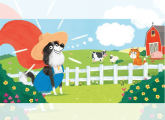Look through them, stand upon them, stack them one inside another – there’s no shortage of fun to be had with tubes, says Wendy Bowkett…
The idea of doing things with tubes really took off one afternoon when I ventured into the cupboard under the stairs at our nursery to get some coloured card for the art room. I couldn’t reach the stash of paper because there were three large cardboard boxes full of junk modelling materials in my way. At the next staff meeting tidying of the ‘art’ cupboard was mentioned and we decided that we should all do more with the ‘junk’ in there.
Starting off with the boxes, children built towers, castles and houses. They added circular pieces of card to make vehicles, and robots had plastic cups and paper bits attached to add to the effect.
There were tubes of all lengths and diameters; they came from the inners of rolls of thread, cash register till receipts,kitchen towels and carpets as well as sticky tape, and sweet and savoury containers. All were donated regularly by parents and staff.
Often, if stuck for ideas, play corners are ideal to use as a starting point. The experiences offered by a play corner usually encourage imaginative skills, whilst also giving you the opportunity to develop other activities which will cover many aspects of the Early Years Foundation Stage.
(Expressive arts and design)
● A pirate theme can be enhanced by making binoculars, telescopes and a simple periscope as well as tubular swords. Make a ‘wooden’ leg with a chopped-down tube from a roll of carpet. Add a circle of sponge glued to cardboard for the top of the leg to protect a bent knee. Attach fabric straps (similar to braces) to either side of the ‘leg’ to fit over each shoulder. The result can be cumbersome and isn’t always comfortable to wear for long, but our ‘wooden’ leg was hugely popular with almost every child! Thinner tubes can be painted or coloured, fabric and feathers added to represent parrots and can then be used as finger puppets.
● Set up camp using different-sized tubes, painted brown, to represent logs for the fire; carpet rolls were cut to make seats and a large piece of fabric over an A-frame for a tent completed the corner. Add a totem pole to change the emphasis of your play area and the children can make smaller versions to take home.
● NASA had competition when some of the tubes were made into rockets and launch pads, not to mention the weird and wonderful aeroplanes and spaceships that hung from the ceilings. Provide plenty of masking tape for activities like this – it adheres to plastic and cardboard, can be torn and painted over, and removes the need for messy glue!
(Personal, social and emotional development)
● Start a tube collection for a different type of display. Will your display only have tubes that are hollow or will you include tubs with lids and bases? What about cylindrical objects such as wooden bricks, tins or pieces of dowelling?
● To encourage observational skills, take a walk to the park and notice how many different tubular objects you can spot. Who can touch the fingers of their hands if they put their arms around a telegraph pole? Our ‘lollipop’ lady had a cylindrical pole to hold up her circular sign. Even the litter bin in the park was on a tubular pole.
● A trip to the supermarket opened our eyes to the variety of cylindrical items for sale. Cut out pictures from catalogues and magazines to make a scrapbook of ‘tubular things’.
(Maths)
● For a small group activity, make an organ with different lengths of tubes and a cardboard box. Our children took several days of planning, organising and helping one another tape the tubing into size order: a lovely way to encourage estimating, comparing and measuring as well as learning the skills to build a structure.
● Place an assortment of tubes and tubs on a surface and ask children to see what they can find. One or two may choose the longest tubes, some may pick out the smallest, while others fit one tube inside another. Give alternative suggestions; the longest or shortest, narrowest or widest, three of the same or five different lengths. Can they make a set of nesting tubes?
● Fitting a square peg into a round hole is the basis of this activity. Choose some solid objects and several tubes with different diameters. Some of the objects will fit quite well, others will need a wider tube. Try the same activity with cut out cardboard shapes. The childen will find that looks can be deceptive! A lovely activity for ‘guesstimating’!
(Physical development)
● Rolling a ball inside a long carpet roll requires a number of skills, including strength, speed, hand-eye coordination and aim. Working in pairs, one child at each end, encourages cooperation and the idea of taking turns as the ball rolls to and fro between partners. How can the ball reach the other end if it stops halfway through the tube?
● The roll from inside a carpet is very sturdy and can be used as ‘cup’ stilts to develop coordination and balance. Cut off two 15cm lengths of tube, drill two holes about 2cm from one end opposite each other on the roll, i.e. 180° apart. Secure rope handles through these holes, making sure that they’re long enough for a child to stand with a straight back on each stilt whilst holding the rope. Add circles of cardboard to the tops of the stilts if required, especially for tiny feet. Always closely supervise this type of activity for obvious health and safety reasons.
● Develop hand-eye coordination and ball skills by using tubes and tubs for playing skittles. Experiment with different diameters of tubes as well as different weights of ball. Does a screwed-up sheet of paper knock down as many skittles as a sponge or ping-pong ball? What size of ball knocks down the most skittles? Can you get a strike if the skittles are spread well apart? If playing outdoors, you may need to add sand or small pebbles to each skittle to prevent any breeze toppling your ‘pins’ before a child has a chance to play.
(Understanding the world)
● Sweet tubes of the same size with removable tops and fixed bases come in very handy for making sound tubes to encourage listening and auditory discrimination skills. Pairs of tubes have different items put into them. Then one tube is shaken or moved gently and its matching ‘sound twin’ has to be found among the other tubes. Have an ‘odd one out’ tube to add to the difficulty. Each tube can be covered with plain or coloured paper to prevent children from matching the pictures on each tube rather than listening for the sounds (watch for children matching by weight too!).
● Introduce environmental issues by using your tube collection to discuss the idea of recycling with your preschoolers. Why do we need to recycle ‘rubbish’? What are the various tubes made from and can they all be recycled? We had plastic tubing on our display table – a piece of drainpipe and garden hose, bendy straws, hollow scoobies and even paint rollers. Find out which can be recycled in your area. Use cardboard boxes to sort out things that can be recycled and those that go to land-fill. All our paper, card and wood scraps went into one bin, plastic in another, fabrics and collage materials in a third. Start your own recycle ‘depot’.
● Ask the children to think about tubes. Could a rabbit burrow be a tube? Or the tunnel under the bypass?Is a funnel a tube? What about a toy drum?
(Communication and language; Literacy)
● Make a tube family – is daddy the tallest, what colour is the daughter’s jumper, how old is the littlest family member? Have they got any pets? Stories about each member of the family can enhance any storytime and with a little imagination, paint and fabric, tubes can become almost any character in a story or rhyme.
● Leave a large cardboard box anywhere in your setting and within seconds it will be played with, talked about and most probably shared. Try it with a water tray full of tubes, piping and tubs, and stand back to listen to the conversations that begin and the language that is used. A simple but effective activity.
● Change words in rhymes and songs to use circle words related to tubular items around your setting. Hoops, rings and quoits are all curved, bent, bowed. Can you add them to Heads, shoulders, knees and toes to make a new song? Change the words to I’m a tube of toothpaste to “I’m a roll of sticky tape”, etc.
Wendy Bowkett has worked in early years settings for over 30 years, and ran her own private day nursery for 15 years. As well as contributing to Teach Early Years, she has written a number of books for those working with 0–5-year-olds.

Audio resources – How to use them in Early Years
Editors picks

Problem solving skills – How shared reading can help
Editors picks
